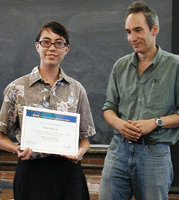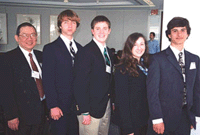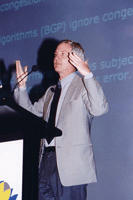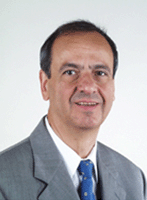Parallel Processing: Top Hot Topic for Spring �08
June 11, 2008

The SIAM Student Chapter at Worcester Polytechnic Institute took to the road last October to attend the 2007 SIAM Conference on Mathematics for Industry. The students presented their work in the minisymposium �Undergraduate Industrial Research at WPI� and in the student poster session. Shown here with WPI faculty Bogdan Vernescu (third from left), Vadim Yakovlev (fifth from right), and Suzanne Weekes (far right), and Olin College faculty member Burt Tilley (far left) are WPI students, past and present, James Lescoe, Morgan Gieseke, Jonathan Adler, Angela Leo, Casey Richardson, Brian Cordes, and Rebecca Wasyk.
Talk of the Society
James Crowley
From time to time, an issue of SIAM News has a theme, and readers will quickly spot a definite emphasis on parallel processing in this one. The inspiration was our biennial Conference on Parallel Processing for Scientific Computing, organized by the SIAM Activity Group on Supercomputing and held in Atlanta, March 12�14. As evident to those who attended the conference, these are exciting times in high-performance computing---driven in part by recent developments in hardware and in part by the many new challenges now being taken up by researchers in large-scale computing.
We thank John Gilbert, Paul Hovland, and Esmond Ng, co-chairs of the conference organizing committee, for agreeing to serve as informal editors of this issue. They mined the program for newsworthy topics and persuaded a few of their colleagues to take the time to write about developments in their areas for general readers of SIAM News. Many thanks to all!
* * *

Reports from SIAM Student Chapters reveal not only a presence at more and more universities but also an impressive array of activities. Shown here is Serina Diniega, president of the chapter at the University of Arizona, receiving a SIAM certificate of recognition from chapter adviser Alain Goriely. Among the chapter events Diniega has organized are research seminars and two noteworthy panel discussions on finding a job, one focused on academia and the other on industry. As to the panels, "the feedback was exceptionally good, and similar events will be organized in the coming years," Goriely says. Diniega, a PhD student who lists her research interests as the use and development of mathematical tools for studying planetary surface features, has also put her energy to work on behalf of the Tucson community at large. This January, for the third time, she was the organizer of the annual Tucson Kids Club math day. Additional information about the Arizona chapter can be found at http://appliedmath.arizona.edu/students/activities/siam/.
SIAM has increased its efforts in the past few years to support activities for students. The tremendous growth in SIAM student chapters is one manifestation of these efforts, which are directed mainly at the upper-level undergraduate and graduate levels. For the last three years, focusing our attention one stage earlier in the development of future applied mathematicians, we have supported the Moody's Mega Math Challenge, a modeling contest for high school students.
Teams of high school students, in a limited but growing geographic region in the northeastern U.S., spend a weekend modeling and analyzing a real-world problem. This year's problem concerned the impact, economic, environmental, social, that would result from the substitution of ethanol for fuel derived from nonrenewable resources. Final judging for the contest took place in late April. A team from High Technology High School in Lincroft, New Jersey, won first prize ($20,000 in scholarships).

Moody's Mega Math Challenge 2008: With a solution titled "Ethanol---Not all it seems to be," a four-student team from High Technology High School in Lincroft, New Jersey, won the top prize (and $20,000 in scholarships) in the annual high school math modeling contest. The students---Afanasiy Yermakov, Thomas Jackson, Kelly Roache, and Jason Zukus---are shown here with their coach, Raymond Eng. Details about the contest can be found at http://m3challenge.siam.org/.
I've had the pleasure of judging the contest all three years, and was especially gratified by the response of students from more than one of this year's top six teams to the question "What were the top two things you learned in this competition?" The students said that, for the first time, they really appreciated the utility of mathematics in analyzing a real problem.
* * *
At the end of April, the U.S. National Academy of Sciences elected 72 new members. Among the group are a few people well known to the SIAM community: Akamai founder Tom Leighton, a professor of applied mathematics at MIT, and Terence Tao, a professor of mathematics at UCLA (who is from Australia and was elected as a foreign associate).


High Honors: Roger Temam of Indiana University and Universit� Paris�Sud (above) was elected to the French Academy of Sciences, and Akamai founder Tom Leighton (top), a professor of mathematics at MIT, was elected to the U.S. National Academy of Sciences.
Earlier this year, we were happy to learn from Matapli (the bulletin of SMAI, the French Soci�t� de math�matiques appliqu�es et industrielles) of the election of Roger Temam to the French National Academy. Temam, who has long divided his time between France and the U.S., is currently a professor emeritus at the Universit� Paris�Sud, at Orsay, and director of the Institute for Scientific Computing and Applied Mathematics at Indiana University.
We encourage readers everywhere to let us know of honors at this level to applied and computational mathematicians in their own countries; messages can be addressed to me ([email protected]) or SIAM News ([email protected]).
* * *
With the approach of summer comes preparation for another round of discussions about science funding within U.S. science agencies. As I write, the National Science Foundation is in the midst of the review process for a major NSF-wide initiative, Cyber-enabled Discovery and Innovation (CDI), and the applied mathematics program in the Department of Energy's Office of Science has received final proposals for its new initiative in multiscale mathematics and optimization for complex systems. "This solicitation targeted a number of areas, including some new ones for the applied mathematics program, that are expected to be of growing importance to DOE throughout the foreseeable future," says Homer Walker, applied math program manager in DOE's Office of Advanced Scientific Computer Research. "The enthusiastic response of the community is very encouraging."
In parallel with these activities has been an effort in the applied math/computational science community to define future research opportunities in applied mathematics for DOE. A report, based on the work of an independent panel chaired by David Brown of Lawrence Livermore National Laboratory, is now available. The panelists, in addition to Brown, were John Bell, Donald Estep, William Gropp, Bruce Hendrickson, Sallie Keller-McNulty, David Keyes,
J. Tinsley Oden, Linda Petzold, and Margaret Wright.
The Brown panel reviewed important areas of interest to DOE---energy, the environment, and national security---and scientific challenges arising in them. Concluding broadly that a scientific understanding of complex physical and engineered systems is needed, the report suggests "a new framework for describing the applied mathematical developments that will be required to address future scientific and engineering challenges for DOE."
Areas covered in the report include predictive modeling and simulation of complex systems, mathematical analysis of the behavior of complex systems, and use of models of complex systems to inform policy makers. Also discussed are complex multiscale systems, stochastic systems, and the incorporation of data into models.
Given the additional challenges of emerging computing architectures, SIAM will post the report by early June (check www.siam.org) and gather comments.
We encourage readers to take the opportunity to express their views on this important report.

